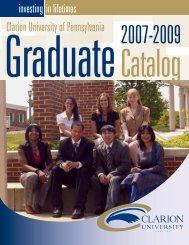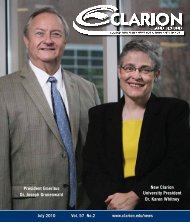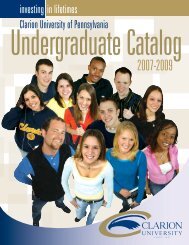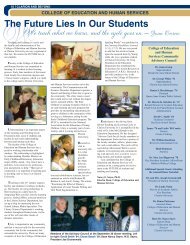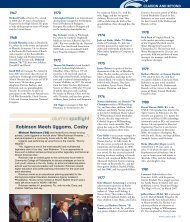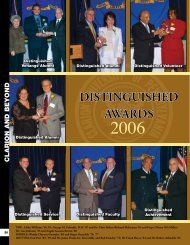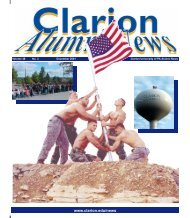Spring 2012 - Clarion University
Spring 2012 - Clarion University
Spring 2012 - Clarion University
You also want an ePaper? Increase the reach of your titles
YUMPU automatically turns print PDFs into web optimized ePapers that Google loves.
Cathy Joslyn guided as<br />
CU students designed<br />
the panels. Pittsburgh<br />
African American Quilters<br />
quilted their work and<br />
attendees signed the gift<br />
that celebrated 10 years<br />
of women’s conferences.<br />
the finaL<br />
Momentum<br />
anne l. Day, Ph.D.<br />
retired Faculty, history<br />
First Chair, status of women<br />
subcommittee<br />
Jane Elmes delivered the keynote address to inaugurate the first <strong>Clarion</strong> <strong>University</strong> Women’s Conference<br />
on April 14, 1984, a regional PASSHE Women’s Consortium gathering. As she concluded her remarks, Jane<br />
reminded the audience of a simple truth: “The initial drive to leadership, and that final momentum, must come from<br />
within.”<br />
I recalled Jane’s comment as I began to write my recollections of that first conference because her words<br />
still resonate with me today. Telling the story of the first Women’s Conference and the eventual founding of the<br />
Women and Gender Studies Program, comes after I look within myself to consider my role in those early days of<br />
struggling and dreaming.<br />
At the request of Dr. Francene McNairy, then chair of the newly formed Affirmative Action Commission,<br />
I chaired the original Status of Women Subcommittee, charged by the university to identify and address the<br />
concerns of women on campus. We met for the first time on December 9, 1983, to assess the needs of campus<br />
women, design long - and short-terms goals to meet those needs, and to identify programs and funding to meet<br />
the goals.<br />
The power within and dedication of the fourteen women and one man who met that day was incredible<br />
and palpable. After much discussion and debate, we chose four specific goals to work toward: (1) identify and<br />
secure a location to establish a returning adult center; (2) identify and secure a location for a women’s center;<br />
(3) organize and implement diverse programs designed to raise the consciousness of the university about the<br />
concerns of women; and (4) monitor and eliminate the use of discriminatory and/or sexist language in campus<br />
communications. It looked so simple and clear on paper!<br />
Both the 1984 and 1985 <strong>Clarion</strong> Women’s Conferences, our first attempts at providing diverse<br />
programming, dealt with the theme of leadership. However, in 1985 we moved away from the regional consortium<br />
model to stand on our own. We wanted to build an annual conference focused on women’s issues relevant to<br />
our own university and community. The buzz phrase was “participatory workshops,” and the raising consciousness<br />
was fast and furious. As the conference chair, I was not alone. My support group cared as deeply as I did and<br />
9




